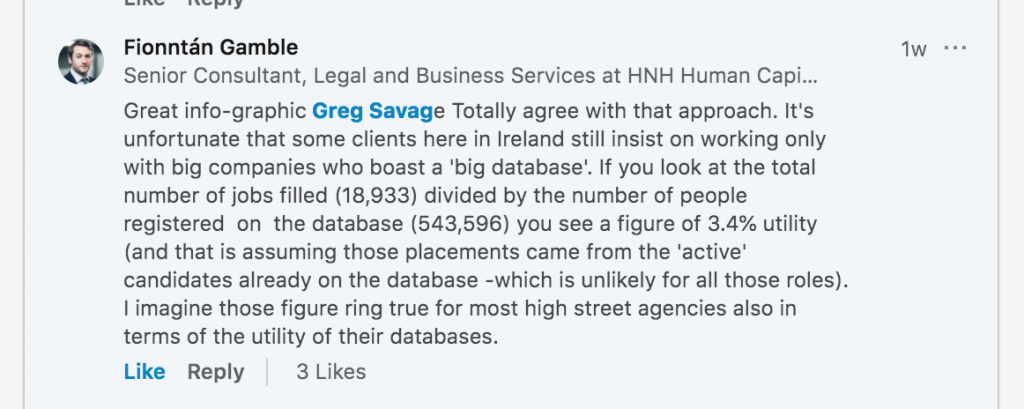Why GDPR is great for recruiters
The GDPR changes how businesses use and store personal data. The forced change in how we communicate is one of the best things to happen to recruiters and agencies for a long time.
Why?
- It reduces the volume of speculative mailshots to candidates and pushes the emphasis back to building and developing focused networks.
- It makes agencies question the £value of their advertising spend.
- It cleans up CRMs storing 000s of outdated records.
- It makes agencies and recruiters think differently about how they approach their marketing and what channels they pursue.
There has been a lot written about the technical requirements of GDPR. This article is about how recruiters can shape their practices to successfully win.
Thinking smaller…
A recent LinkedIn post from an agency highlighted social, CRM and conversion metrics. The CRM contained 543,000 records. With 131 active employees on LinkedIn, and assuming 10% of those are non recruiters – you’ve got a candidate to recruiter ratio of 4,601:1. If you spoke to all 4,601 candidates for 30 mins, that’s 63 days on the phone. Impossible.

Kudos to this guy
So, what’s the opportunity?
Review your KPIs and reshape business values.
If your businesses values are “respect”, “loyalty”, “ambition” or similar words describing how you treat people – change them to “network”, “focus” and “results”.
Clients and candidates don’t work with you because you have “respect” – that’s a base minimum for any engagement. They work with you because you have the best candidates and the best processes.
Reviewing your KPIs against results achieved will help understand which areas to ‘dial-up’ and which to drop.
Areas to consider:
- Standardise CRM activity, set clear rules for how long you keep data and how you record actions and tags.
- If you’re attracting candidates via job board adverts who are already on your CRM, you’re wasting time .
- Create a framework to increase referral generation
- Improve how you report on candidate attraction to maximise budget
Solving the ‘broken processes around interviews and recruiting’
In March, Stackoverflow published results from their 2018 annual survey, which received over 100k responses from IT professionals.
“Recruiter” ranked number three for “annoying” and “five” for “exhausting” to the question “What Words Do Developers Use to Describe Searching for a Job?”.
Survey respondents also “expressed frustration with broken processes around interviews and recruiting.”


‘Broken processes around interviews and recruiting’ are shared frustrations. On one hand you’ve got a recruiter who has targets to meet and on the other passive and active candidates who want clear communication.
So, what’s the opportunity?
I’ve long been an advocate of smaller focused networks, having viewed their success in industries as disparate as IT, construction and education. The commonality in this approach is the relationship between the recruiter and their:
- Specialism
- KPIs / targets
- Personal brand
Each of the most successful recruiters I’ve known think commercially first asking “what do I need to do to hit this number?” closely followed by “does this action add £value?” and thirdly “how does this action impact me as a professional?”
A fresh approach for recruiters looking to get ahead pre and post GDPR is to map out their day-to-day processes, dropping any actions which don’t impact £value.
One approach to solving the ‘broken processes around interviews and recruiting’ is to build dedicated network based on T-shaped individuals.
A “T-shaped individual” has been used by HR professionals since the early 90s. Coined by David Guest, The vertical bar on the T represents the depth of related skills and expertise in a single field, whereas the horizontal bar is the ability to collaborate across disciplines with experts in other areas and to apply knowledge in areas of expertise other than one’s own.
The benefits of this approach are:
- A rock-solid network of professionals with a combination of ‘deep’ and ‘broad’ skills
- Streamlined communication
- Easier to run and manage referral activity
Using IT as the example, if you think of the candidate network in relation to programming languages, you can begin to map:
- How many candidates you need in your network to hit your numbers
- How many ‘T’s’ (broad specialists)
- How many ‘I’s’ (deep specialism)
Then, layer on top of you network, the most desired benefits candidates look for when moving jobs*:
- The compensation and benefits offered
- The languages, frameworks, and other technologies they’re working with
- Opportunities for professional development
- The office environment or company culture
- The opportunity to work from home/remotely
*Top priority in assessing a job: Stackoverflow survey.

By building a network of 50 rock-solid candidates, fully mapped out with their needs and wants, you will be able to start a conversation with any client on their hiring needs. Similarly, you’ve got 50 candidates that may be passive or active that you can exchange information with. The strength of your connections will influence how you can reach other candidates in their network.
********
Ultimately, building your network takes planning, time and dedication. If you focus on the opportunity that GDPR creates and market yourself as someone who acts differently, you will achieve great results, both short and long-term.
For more fresh thinking on how to grow your recruitment business, download our eBook below.
